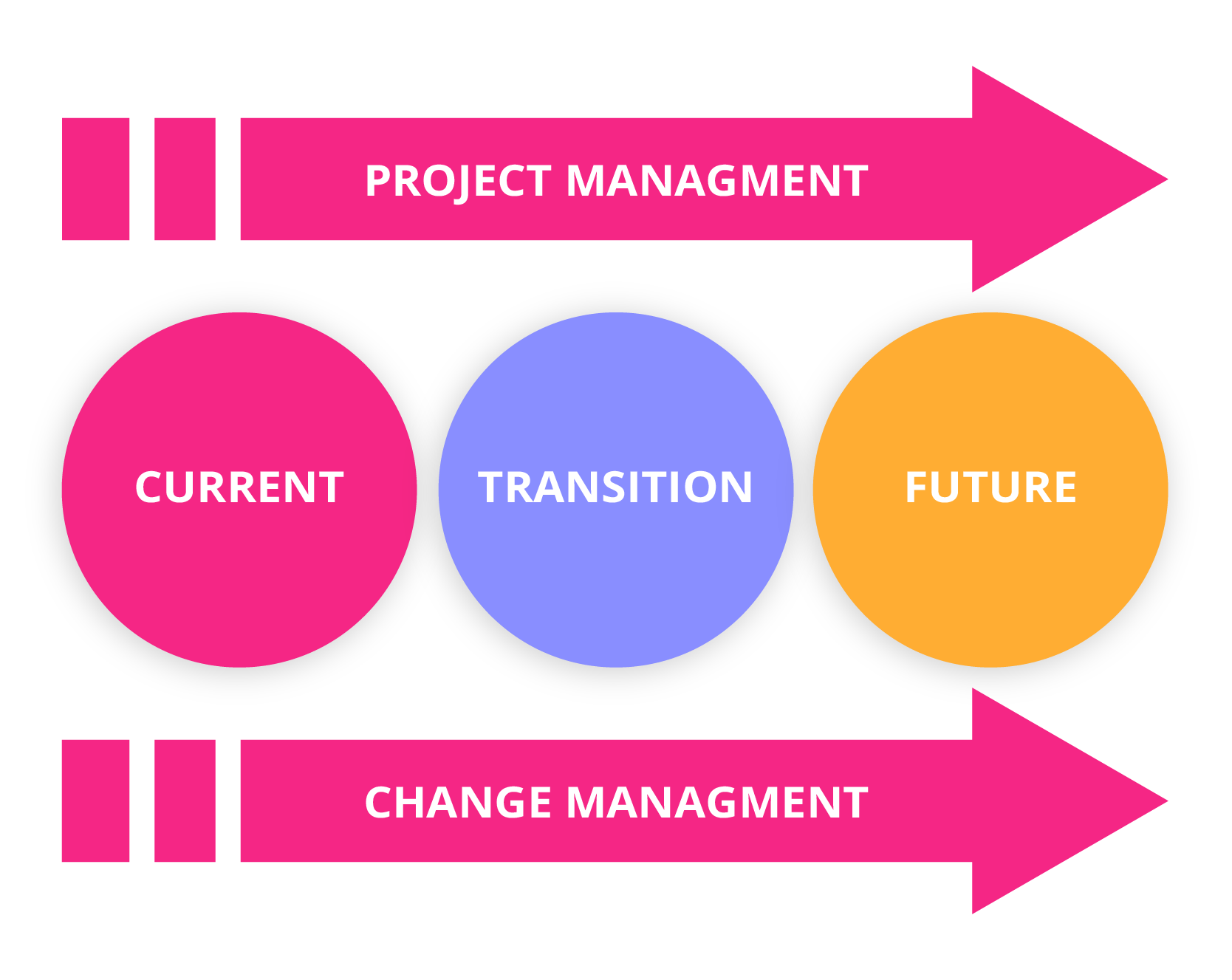Integrating Change Management and Project Management Within Your Organisation
Change management and project management are both important, and often work in parallel with each other in an organisation. Yet their functions and objectives are often viewed in isolation, with different purposes and outcomes. However, when the two are integrated, they can ensure a company’s processes are as efficient as possible, and that employees remain motivated and productive.
Change management is people-focused, and serves as a guide to how a business can prepare, equip, and support employees to embrace change in ways that may result in greater organisational success.1 Change management also reduces the potential risk that any changes may be rejected by the people within the business.2 While change management might not have a visible impact on the bottom line, it does enable the teamwork and cohesion needed for an organisation to accept change and operate more efficiently.
Project management, on the other hand, pertains to achieving specific project outcomes within budget and on time by applying processes, methods, skills, insight, and experience based on the project acceptance criteria within agreed parameters.3 Project management oversees every aspect of a project, from people to tasks to tools.4
Strong project management skills can save an organization time and money. Learn how to approach and execute projects more effectively and efficiently with the UCT Project Management course. Stand out from the crow with newfound project management skills.
Project management vs change management
Change management and project management cross paths throughout the life cycle of a project or initiative, as each of these bring required and important structure and process that enable the effective implementation of change and project outcomes. Here’s how they compare:


Why integrating change management and project management is important

When a project brings about changes within a business, these need to be efficiently managed on both the human as well as project level.9 The project-level focus means that the change is developed, designed, and implemented effectively through the structure, processes, and tools provided by project management. The human-level focus means that the changes are successfully adopted and used by the employees who have to learn how to perform their jobs effectively as a result of the project.
Project management and change management both seek the successful delivery, outcome, and implementation of projects or initiatives within a business. While each discipline can function in isolation, integrating change management and project management is the most effective approach, offering multiple benefits:
- Shared objective.10 Integrating change and project management efforts provides a singular focus and united objective for both teams. This improves the performance of the business by successfully delivering and bringing about a change that delivers the intended outcomes.
- Proactive steps.11 Managing the human aspect of change becomes more proactive in an integrated system, as obstacles and resistance can be identified and proactively mitigated, ensuring greater buy-in of the project throughout every step of execution.
- Sequencing and alignment.12 When project and change activities are integrated, it ensures the steps that need to be carried out in the project life cycle are carried out in the right order. This facilitates the adoption of change by employees and thus produces the desired outcomes of the project.
- Exchange of information.13 The flow of communication and information is improved with the integration of these disciplines. From the front-end, impacted employees are kept up to date and receive appropriate messaging, while on the project-facing side, teams are able to receive feedback on adoption, usage, and response to the project’s changes.
How to successfully integrate change management and project management
Even if change management and project management are both present in an organisation, it doesn’t mean they are integrated. There are prerequisites required to successfully integrate change and project management:
- A united focus on results and outcomes.14 The project team needs to have a clear focus on the broader desired results and outcomes of the project, and must be responsible for delivering these outcomes. This is more than simply reaching a deadline. Similarly, change management needs to align their own outcomes with the wider project objectives and outcomes, over and above the more typical change management outcomes, such as business communications and employee training. Having a shared focus on results and outcomes is pivotal to successful integration of project and change management.
- Recognise the role and value of change management.15 The value of change management must be acknowledged as a crucial component of project delivery in order for integration to be successful. It must be understood that the application of change management to a project will have direct benefits on achieving the desired outcomes of the projects.
- Integrate processes.16 When integration takes place, the activities of project management and change management activities are brought together within the life cycle of the project. This allows these complementary disciplines to effectively sequence work, timing, and information exchange. Here is how to integrate processes:
- Structure: Approach change management from a process-oriented and milestone-driven angle in order to make integration with project management activities more effective
- Deliverables: Concrete change management deliverables will ensure greater integration with project management
- Identify key points in time for integration: During the life cycle of the project there are certain points at which integration of activities is more important than others, such as risk identification, solution design, project communication, and system testing. Integration of activities during these phases should be more holistic and focused

- Integrate tools.17 Integration at the tool dimension will allow a focus on the specific deliverables created by both disciplines. There are many tools that can be used by both project management and change management, such as the communication plan, and risk assessment tools. This integration makes a single tool plan that incorporates the people as well as the project aspects of the project. Here is how to integrate tools:
- Identify specific tools that make sense for integration. There are tools that are commonly used for project management, such as stakeholder analysis, risk identification and communication plans, that can easily be adapted to cover change management activities.
- Work with what the other team has already done. Rather than excluding or redoing work that has already been done by either role, show how each can add value to the other’s process.
- Ensure ownership is clear. Clarify early on in the process which team will maintain and own the tool, while still including both teams’ perspective, in order to avoid each team assuming that the other is taking responsibility for an activity.
Success for a project comes from an effectively designed, developed, and delivered initiative that is welcomed, adopted, and applied by the employees that are impacted by it.
No matter what approach is used to integrate people, processes, tools and methodologies, integrating change management and project management affords a more united approach and solution to bring about sustained and meaningful change in a business.
- 1 (Nd). ‘What is change management’. Retrieved from Prosci. Accessed 17 June 2019.
- 2 Perkins, B. (Apr, 2018). ‘What is change management? A guide to organizational transformation’. Retrieved from CIO.
- 3 (Nd). ‘What is project management?’. Retrieved from APM. Accessed 17 June 2019.
- 4 (Nd). ‘What is project management?’. Retrieved from Wrike. Accessed 17 June 2019.
- 5 Creasy, T. (Oct, 2018). ‘Project management and change management: a side-by-side comparison’. Retrieved from Prosci.
- 6 (Sep, 2018). ‘Understanding the difference between project management and change management’. Retrieved from Lucidchart.
- 7 Creasy, T. (Oct, 2018). ‘Project management and change management: a side-by-side comparison’. Retrieved from Prosci.
- 8 (Sep, 2018). ‘Understanding the difference between project management and change management’. Retrieved from Lucidchart.
- 9 (Nd). ‘Integrating change management and project management’. Retrieved from Prosci. Accessed 17 June 2019.
- 10 (Nd). ‘Integrating change management and project management’. Retrieved from Prosci. Accessed 17 June 2019.
- 11 (Nd). ‘Integrating change management and project management’. Retrieved from Prosci. Accessed 17 June 2019.
- 12 Marsicano, N. (Feb, 2019). ‘Change management in project management, starting points for an effective integration’. Retrieved from And Change.
- 13 Marsicano, N. (Feb, 2019). ‘Change management in project management, starting points for an effective integration’. Retrieved from And Change.
- 14 (Nd). ‘5 dimensions of integrating change and project management’. Retrieved from Prosci. Accessed 17 June 2019.
- 15 (Nd). ‘Integrating change management and project management’. Retrieved from Prosci. Accessed 17 June 2019.
- 16 (Nd). ‘5 dimensions of integrating change and project management’. Retrieved from Prosci. Accessed 17 June 2019.
- 17 (Nd). ‘5 dimensions of integrating change and project management’. Retrieved from Prosci. Accessed 17 June 2019.